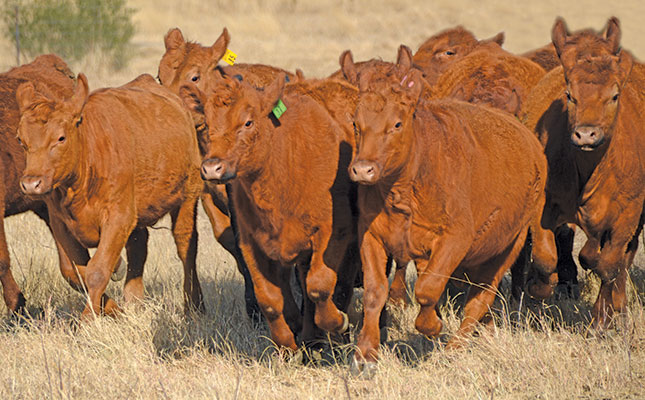
Photo: FW Archive
The general perception within the beef production industry is that it is only stud breeders who can benefit from performance testing. This is simply not true! The commercial farmer can improve his or her own enterprise with regard to herd management and cow fertility, as well as the productivity and profitability of the herd.
The National Beef Recording and Improvement Scheme (NBRIS), managed by the Animal Production Institute of the Agricultural Research Council (ARC), has all the necessary tools to assist farmers in becoming commercially productive and making the transition from emerging to commercial farmers.
The question has been asked, “When can a farmer be considered a commercial farmer and no longer an emerging farmer?” The answer is, when such a farmer can produce and deliver a product, such as meat, in the form of a weaner calf to a feedlot.
To be profitable, a commercial farmer needs to produce the optimal number and weight of weaner calves per cow mated at the lowest cost possible. Weaner calves should be marketed as economically as possible directly after weaning at the optimal weight. Fertility is crucial to achieving this efficiently, and the growth ability of calves from birth to weaning is no less important. Post-wean growth is of particular importance to the feedlot industry.
The basis of good reproduction management is excellent record-keeping, as this enables the breeder to make informed ion decisions to achieve the desired objectives. Phases A and B of the NBRIS offer a platform to commercial breeders to measure animals in phases to support these objectives on the road to financial success.
Certain management practices, such as weighing of animals at birth and weaning, are already carried out by farmers but, in addition, these weights need to be sent to the national database, which is the Integrated Registration and Genetic Information System, or Intergis.
The capturing on this system is vital for the data to be processed and turned into useful information, which is sent back to breeders in the form of reports on the productivity and efficiency of the herd. This information helps breeders decide which animals to cull and which to keep.
Management practices
It is important to implement and maintain certain management practices in a structured way to ensure meaningful processing of data into information. Most important is a fixed breeding season lasting a maximum of three months.
The specific period is dependent on the regional rainfall season of the year, and must be planned to maximise the utilisation of natural grazing at its peak period, when the nutritional needs of the lactating cow peaks, and also to maintain the condition and weight of cows and heifers at the start of the mating season. The lactating cow’s nutritional needs peak during the six weeks after the birth of her calf.
Newborn calves
All newborn calves need to be recorded and identified with an appropriate identification system on-farm, which is typically an ear tag showing the birth date. This information, together with the birthweight, should be captured on Intergis.
It is also important to record stillborn calves to accurately calculate traits such as ‘age at first calving’ and ‘intercalving period’. The latter is the period in days between two calvings, and is an indication of the level of reproduction and fertility of the cow, which is the most important trait to be measured in a herd.
Cow weights can be taken at birth or when the calf is weaned. The latter is normally the easiest and most practical time to weigh the cow. The purpose of a weaner production system is to achieve the optimal weaning weight at the lowest cost per breeding animal, which is the cow in this case. It is therefore also important to limit cow weights in order to minimise input costs.
Selection and management must concentrate on improving production or output. The objective is to wean a calf of at least 45% of the dam’s body weight.
When the calves are seven to eight months old, the breeder can request a specific form, the ‘wean weigh list ‘, from the ARC. All the farmer’s calves born in the previous calving
season will also appear on this weigh list. The weaning weights as well as the date of weaning need to be completed on the weigh list and sent back to Intergis to be captured.
This enables the system to calculate the standard 205-day weight for each calf in the weaning group, as well as an index value to indicate the performance of the calf compared with the average performance of the group.
Animals within the same weaning group will vary in age by up to three months from the youngest to the oldest due to the three-month period of the breeding season, and this can complicate the comparison of animals based on performance within the group. The older animals always have an advantage over their younger contemporaries, and the bulls over the heifers.
For this reason, weaning ages are standardised to a 205-day age and are calculated for the entire weaning group. A new report, the wean test report, is then generated. This shows the weaning weight, adjusted 205- day weight and 205-day weight index, which enables the breeder to fairly compare animals based on their growth performance.
Wean production report
The weaning index for each animal is its performance expressed as a percentage compared with the group average, which is always 100%. All animals with a weaning index greater than 100 are above average, while those below 100 are below average.
The wean test report contains the complete weaning group with weaning weights, 205- day weights, and wean indices for comparison purposes. The breeder can use this report to identify calves with the best growth ability within the group, as well as heifers for potential replacement of older cows that become less efficient over time. The weaning weight of the calf is an indication of its genetic ability to grow, as well as its dam’s milk production.
After weaning
The general practice followed by commercial farmers is to market all bull calves after weaning, but only once the preliminary ion of potential replacement heifers has already been made. This means that mainly heifers will remain on the farm and proceed from the weaning phase to the next phases, which are phase B1 (12 months of age) and B2 (18 months of age).
Post-wean production reports
In addition to the wean test report, post-wean reports are generated for animals of 12 and 18 months of age; these serve mainly as information for the ion of replacement heifers. Phase B is an on-field test for adapted female animals, and growth performance can be evaluated without the influence and support of the dam from weaning until the age of 18 months.
Reproduction Report
The reproduction report, also known as the breeding herd report, contains a list of all active cows and heifers above 24 months of age. It contains reproduction information such as the number of calves, age at first calving, intercalving period, and the average weaning index for all calves weaned per cow.
The average weaning index per cow is valuable in determining the efficiency of the cow, as it takes into consideration her milk production as well as her ability to wean an above-average calf in the herd.
If she is not efficient enough or doesn’t produce a calf every year, it might be better to replace her with a good-quality heifer. Age at first calving is a fertility trait that enables the breeder to identify cows that calve earlier in the calving season, and to allow for more recovery time for the cow to ensure she is in better condition for the next mating season.
Benefits of performance testing
Performance testing improves management in general, and also has many other benefits:
- Breeding seasons ensure optimal utilisation of natural pastures, especially when the lactating cow’s nutrient requirements are peaking, with cost-saving on additional feed.
- Reproduction records per cow are d after each event, and the cow can be evaluated on a regular basis to ensure efficiency of the herd.
- Data is saved on a central database and mitigates the risk associated with theft or damage to a personal computer.
- Subsidised services are rendered by the ARC at an affordable fee and there are regional personnel offering support in all provinces.
- A unique member number with herd designation mark is allocated to each producer, with a user name enabling breeders to log on to Intergis to generate lists and reports as needed.
- Support is available from ARC personnel in all provinces regarding the purchase of registered bulls that support breeding objectives, such as improvement of growth and milk production.
- ARC technicians who have completed inspector courses can also assist with ion of breeding material.
Email Dr Ben Greyling at ben@arc.agric.za.

.jpg)






